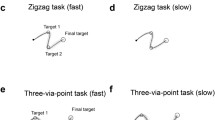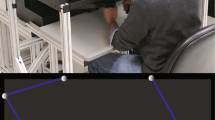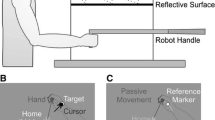Abstract
Adaptation to an abrupt change in the dynamics of the interaction between the arm and the physical environment has been reported as occurring more rapidly but with less retention than adaptation to a gradual change in interaction dynamics. Faster adaptation to an abrupt change in interaction dynamics appears inconsistent with kinematic error sensitivity which has been shown to be greater for small errors than large errors. However, the comparison of adaptation rates was based on incomplete adaptation. Furthermore, the metric which was used as a proxy of the changing internal state, namely the linear regression between the force disturbance and the compensatory force (the adaptation index), does not distinguish between internal state inaccuracy resulting from amplitude or temporal errors. To resolve the apparent inconsistency, we compared the evolution of the internal state during complete adaptation to an abrupt and gradual change in interaction dynamics. We found no difference in the rate at which the adaptation index increased during adaptation to a gradual compared to an abrupt change in interaction dynamics. In addition, we separately examined amplitude and temporal errors using different metrics, and found that amplitude error was reduced more rapidly under the gradual than the abrupt condition, whereas temporal error (quantified by smoothness) was reduced more rapidly under the abrupt condition. We did not find any significant change in phase lag during adaptation under either condition. Our results also demonstrate that even after adaptation is complete, online feedback correction still plays a significant role in the control of reaching.









Similar content being viewed by others
References
Albert ST, Shadmehr R (2016) The neural feedback response to error as a teaching signal for the motor learning system. J Neurosci 36:4832–4845
Balasubramanian S, Melendez-Calderon A, Burdet E (2012) A robust and sensitive metric for quantifying movement smoothness. IEEE Trans Biomed Eng 59:2126–2136
Franklin DW, Osu R, Burdet E, Kawato M. Milner TE (2003) Adaptation to stable and unstable dynamics achieved by combined impedance control and inverse dynamics model. J Neurophysiol 90:3270–3282
Franklin DW, Burdet E, Tee KP, Osu R, Chew CM, Milner TE, Kawato M (2008) CNS learns stable, accurate, and efficient movements using a simple algorithm. J Neurosci 28:11165–11173
Hinder MR, Milner TE (2005) Novel strategies in feedforward adaptation to a position-dependent perturbation. Exp Brain Res 165:239–249
Huang VS, Shadmehr R (2009) Persistence of motor memories reflects statistics of the learning event. J Neurophysiol 102:931–940
Klassen J, Tong C, Flanagan JR (2005) Learning and recall of incremental kinematic and dynamic sensorimotor transformations. Exp Brain Res 164:250–259
Marko MK, Haith AM, Harran MD, Shadmehr R (2012) Sensitivity to prediction error in reach adaptation. J Neurophysiol 108:1752–1763
Milner TE (2002) Adaptation to destabilizing dynamics by means of muscle cocontraction. Exp Brain Res 143:406–416
Milner TE, Franklin DW (2005) Impedance control and internal model use during the initial stage of adaptation to novel dynamics in humans. J Physiol 567:651–664
Milner TE, Ijaz MM (1990) The effect of accuracy constraints on three-dimensional movement kinematics. Neuroscience 35:365–374
Pekny SE, Criscimagna-Hemminger SE, Shadmehr R (2011) Protection and expression of human motor memories. J Neurosci 31:13829–13839
Scheidt RA, Reinkensmeyer DJ, Conditt MA, Rymer WZ, Mussa-Ivaldi FA (2000) Persistence of motor adaptation during constrained, multi-joint, arm movements. J Neurophysiol 84:853–862
Smith MA, Ghazizadeh A, Shadmehr R (2006) Interacting adaptive processes with different timescales underlie short-term motor learning. PLoS Biol 4:e179
Thoroughman KA, Shadmehr R (1999) Electromyographic correlates of learning an internal model of reaching movements. J Neurosci 19:8573–8588
Acknowledgements
This study was funded by a grant from the Natural Sciences and Engineering Research Council of Canada. We thank Shahab Vahdat and Mohammad Darainy for the technical assistance. We thank the anonymous reviewers for their helpful suggestions.
Author information
Authors and Affiliations
Corresponding author
Rights and permissions
About this article
Cite this article
Milner, T.E., Firouzimehr, Z., Babadi, S. et al. Different adaptation rates to abrupt and gradual changes in environmental dynamics. Exp Brain Res 236, 2923–2933 (2018). https://doi.org/10.1007/s00221-018-5348-6
Received:
Accepted:
Published:
Issue Date:
DOI: https://doi.org/10.1007/s00221-018-5348-6




